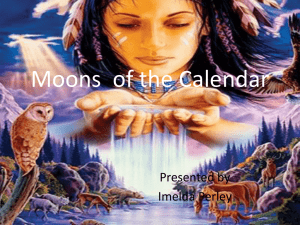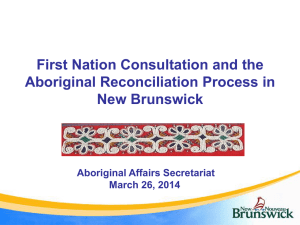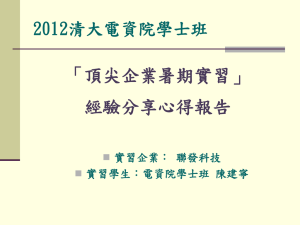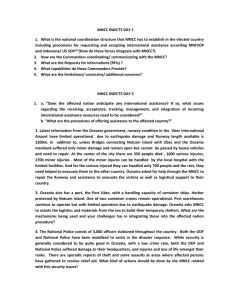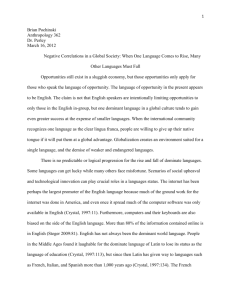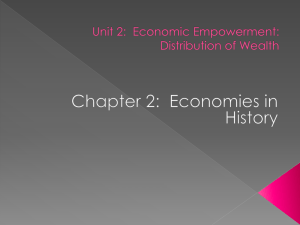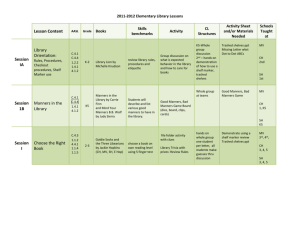MTK-Protocol1 - Maliseet Nation Conservation Council
advertisement
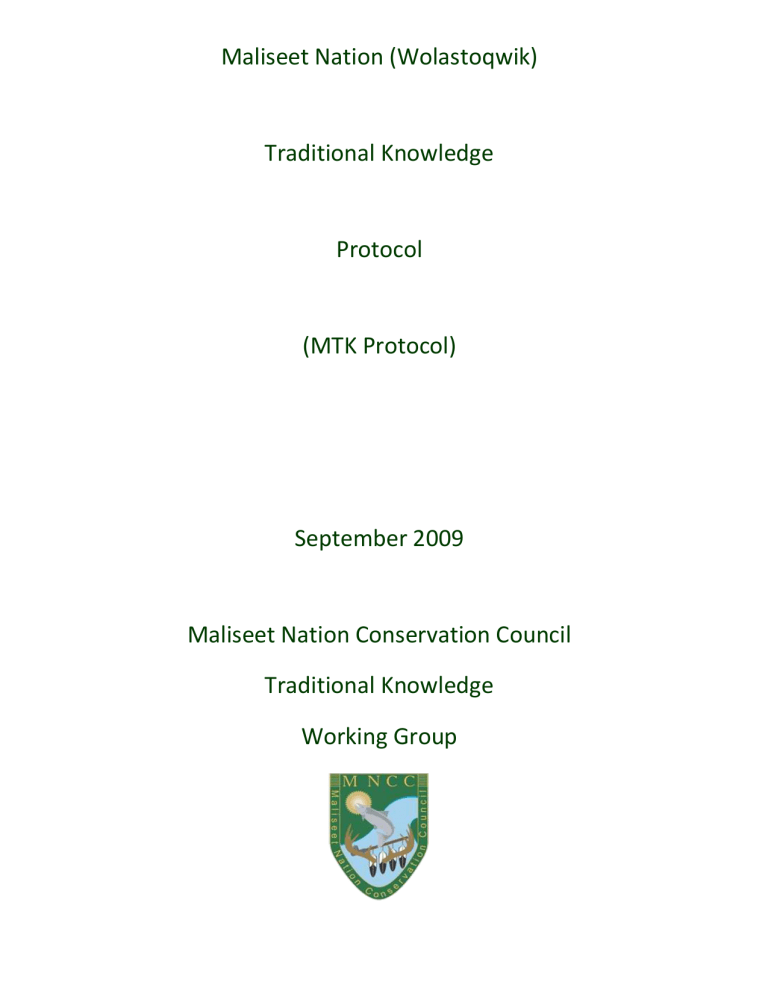
Maliseet Nation (Wolastoqwik) Traditional Knowledge Protocol (MTK Protocol) September 2009 Maliseet Nation Conservation Council Traditional Knowledge Working Group Table of Contents Foreword …………………………………………………………………………… i 1.0 Introduction ………………………………………………………………… 1 2.0 Definitions …………………………………………………………………… 2 3.0 Interpretation ………………………………………………………………… 3 4.0 MTK Methodology …………………………………………………………… 4 I Project Planning ………………………………………………………… 5 II Delivery and Implementation ……………………………………………… 6 III Finalizing Report and Disclosure ………………………………………… 7 5.0 Amendments …………………………………………………………………… 7 Appendices …………………………………………………………………………… 8 Maliseet Leadership Proclamation / Resolution …………………………… Draft Maliseet Ethics Guidelines ……………………………………… 9 10 Foreword Development of the Maliseet Nation Traditional Knowledge (MTK) Protocol highlights the recognition of the importance of Aboriginal traditional knowledge in relation to the environmental issues facing Maliseet traditional territory and the Saint John River (Wolustok) watershed1. The protection of such knowledge has been identified by the Maliseet Chiefs as a crucial component for future relations with non-Aboriginals, as increasing development activity continues to cause 1 See UN Declaration on the Rights of Indigenous peoples UNGA UN Doc. A/61/L.67, preamble (“Recognizing that respect for indigenous knowledge, cultures and traditional practices contributes to sustainable and equitable development and proper management of the environment”), Articles 25-27, 31. See also Convention on Biological Diversity, 5 June 1992, 1760 UNTS 79, Article 8(j), Rio Declaration on the Environment and Development United Nations Conference on the Environment and Development, Annex, Resolution 1, UN Doc. A/conf.151/126/Rev.1(vol.1) (1993), Principle 22, Among other international sources recognizing a rights-based dimension to traditional knowledge and a potentially important role for traditional knowledge in environmental management generally. concern for all parties on the best way to proceed, in the spirit of cooperation and with due respect for Maliseet Aboriginal and Treaty rights1. The protocol also addresses past problems with research projects such as lack of consultation of Maliseet people, lack of meaningful community involvement, lack of benefit from research, lack of informed consent, lack of community ownership of data (including analysis, interpretation, recording or access), and lack of respect of our culture and beliefs by outside researchers. Initiated by the Maliseet Nation Conservation Council and produced through the combined efforts of informed Maliseet Elders, leaders, committees and grassroots volunteers, this protocol identifies the methods developed by the Maliseet Nation for the proper and thorough collection and use of traditional ecological knowledge (TEK). It also provides for the increased employment of Maliseet people in conducting all aspects of these types of studies, reflecting the desire for increased community control of both the process and use of the results. The Maliseet Nation Conservation Council, representing all Maliseet First Nation communities, has developed this MTK Protocol through a working group dedicated to ensuring a reliable system for the collection and use of Maliseet traditional ecological knowledge. The working group, comprised mainly of Maliseet Elders and Leaders, reviewed best practices of other Aboriginal nations, and participated in several meetings and conferences to develop the draft protocol. A Maliseet Research Review Board is being developed at this time as a component of MNCC’s overall mandate to implement this protocol. Ratified by Maliseet leadership in September 2009, this MTK Protocol was developed for the purpose of establishing the proper conduct of traditional ecological knowledge or other research studies within Maliseet traditional territory, with consideration of the rights of the Maliseet people, and therefore in the event of any conflict, shall prevail over any other protocol within the said territory. 1.0 1 Introduction See eg. Canadian Environmental Assessment Act, 1992 c.37, s.16. (Community knowledge and aboriginal traditional knowledge may be considered in conducting an environmental assessment), Species at Risk Act, 2002 c.29 preamble (the traditional knowledge of the aboriginal peoples of Canada should be considered in the assessment of which species may be at risk and in developing and implementing recovery measures), s.10.2 © stewardship action plans prepared by the Minister in consultation with COSEWIC must include methods for sharing information about species at risk, including community and aboriginal traditional knowledge, that respect, preserve and maintain knowledge and promote their wider application with the approval of the holders of such knowledge, with governments and persons), s.16 (Composition of COSEWIC expert committee must include those with expert qualifications, including community knowledge or aboriginal traditional knowledge, of the conservation of wildlife species). The traditional territory of the Maliseet Nation largely coincides with the Saint John River watershed, an area of 55,000 square kilometers, starting in the State of Maine, USA and continuing through the provinces of Quebec and New Brunswick to the Bay of Fundy in the south. The Maliseet name for the Saint John River watershed is the “Wolustok”, meaning the beautiful river, and “Wolastoqwik”, meaning people of the beautiful river. Maliseet leadership formed the MNCC in 2004 in order to speak with a united voice on matters concerning tribal or watershed matters, to develop capacity in watershed comanagement, and to advise Maliseet leadership on issues that may pose a threat to Maliseet territory, now or in the future. Saint John River Watershed The Maliseet Nation Conservation Council (MNCC) hosted a conference in March of 2009 to address the issue of a lack of a protocol for the collection and use of Maliseet Nation traditional ecological knowledge. This conference led to the formation of the MNCC Working Group on MTK. Consisting mainly of Elders and Maliseet leaders, the working group provided input on what the draft protocol should look like, how and when it should be used, important related issues such as ethics and ratification, and what critical components such a protocol should contain. The working group also provided input in the draft Maliseet Chiefs Proclamation, mandating the MNCC to represent the Maliseet Nation with regard to MTK issues, providing a central agency for government, industry, researchers and First Nations to work together in conducting TEK studies in Maliseet territory. The MNCC was appointed to implement the MTK Protocol, to organize the Maliseet Research Review Board, and establish the Maliseet Nation Archives so as to ensure development of sustainable, long-term benefits for the Maliseet Nation as we move toward increased co-management in our traditional territory. 2.0 Definitions “Consultant” means a company, group or individual responsible for the conduct of a Maliseet Traditional Knowledge study within Maliseet traditional territory, the Saint John River (Wolustok) watershed, including parts of the Bay of Fundy. “Consultation” means any negotiations or meetings with representatives of government, related to potential infringement of Aboriginal, Treaty or Title rights or environmental or other impacts on “crown lands” within the said territory. “Government” means any federal, provincial or municipal department, agency or representative. “Maliseet Nation Archives” means the services performed by MNCC related to information indexing, storage, backup, and retrieval of various MTK materials, including original interview documents, videos, GPS maps, electronic database or other materials produced during an MTK Study. “Maliseet Nation Leadership” means the elected political leaders of the Maliseet Indigenous communities located throughout the Saint John River watershed. “MNCC” means the Maliseet Nation Conservation Council Inc., formed in 2004, responsible for development and implementation of the MTK Protocol. “MNCC” means the Maliseet Nation Conservation Council Inc. “MRRB” means the Maliseet Research Review Board, formed in 2009, responsible for the implementation of the Maliseet Ethics Guidelines. “MTK” means Maliseet Traditional Knowledge, and includes but is not limited to Maliseet culture, customs, oral history, or archived material. “MTK Study” means any study or project that is designed to capture and record patterns of traditional use by Maliseet communities, both historical and contemporary, in Maliseet traditional territory, and includes planning, collection, analysis, reporting and distribution of MTK. “MTK Working Group” means the ad hoc MNCC committee formed in March 2009, responsible for the development of draft and final versions of the MTK Protocol “Project” means any official undertaking which triggers an MTK Study to be conducted, and includes such undertakings as Aboriginal Traditional Knowledge (ATK), Traditional Ecological Knowledge (TEK), Traditional Use Study (TUS), socio-economic impact assessments, cultural resource management studies, environmental impact or archaeological assessments or other ecological studies. 3.0 Interpretation 3.1 Nothing in this MTK Protocol or any related discussions, communications or documentation shall be interpreted as to abrogate, derogate, or in any way, affect, limit or detract from the Aboriginal, Treaty or Title rights of any member of the Maliseet Nation. 3.2 Nothing in this document shall be interpreted as Consultation for the purpose of justifying an infringement on Maliseet Aboriginal, Treaty or Title rights, or as satisfying the duty to consult and accommodate the Maliseet Nation, unless otherwise provided for in writing and sanctioned by Maliseet Nation Leadership. 3.3 This MTK Protocol is intended to complement and support the operation of the Maliseet Research Review Board (MRRB), that pertains to MTK data collection and, in the event of a conflict between this protocol, and any other guidelines or laws, the guidelines in this Protocol, including the Maliseet Ethics Guidelines, shall take precedence. 4.0 MTK Methodology 4.1 MTK Study methodology provides standards and recommended guidelines for all stages of an MTK Study, including the planning, implementation and reporting thereof. Phase I – Project Planning 4.2 The MNCC will act as the central agency responsible for the administration and oversight of all stages of the MTK Protocol, including planning and initiation. MNCC will advise the Consultant on communications strategy in order to effectively provide information on each Project, Consultants and Proponents, MTK processes, and gather feedback. MNCC shall act as the contact organization for MTK studies taking place in the traditional territory of the Maliseet Nation. Though the exact scope of the planning phase of each MTK study will vary from project to project, each should have consideration of the following components: 4.3 Research Principles – Maliseet Ethics Guidelines With respect to certain matters, the Maliseet Ethics Guidelines may apply in conjunction with, or in advance of, the MTK Protocol. The Maliseet Ethics Guidelines identifies approved research principles and methods. Administered by the Maliseet Research Review Board (MRRB), the ethical guidelines provide proper procedures for the collection; analysis and reporting of research data generated from Maliseet communities. These matters include, reviewing research proposals, monitoring research projects, review of research methodologies, repatriation of Maliseet artifacts and burial items, and others. The (draft) Maliseet Ethics Guidelines is attached to this document and marked Appendix “B” 4.4 Role of the MNCC in phase I activities • Determinations of what activities will trigger an MTK or MRRB Study; • Meeting with Government and Industry in relation to resource developmentdiscussions in Maliseet traditional territory; • Developing discussions as early in the process as possible; • Communicating the MTK Protocol requirements to consultants, projectproponents, Maliseet communities, and other interested parties; • Coordination with the MRRB on matters of an ethical nature; Phase II – Conducting an MTK Study There are four main considerations related to the execution of MTK Studies: research principles, communications, information collection and storage, and the role of the MNCC. 4.5 Research Principles Various research principles are addressed in detail in the MRRB Maliseet Ethics Guidelines. These principles include: • • • • • 4.6 Maliseet holistic perspective Sacred sites and traditional knowledge Community jurisdiction and approval / participation process Informed consent procedures (individual and community) Confidentiality / privacy Protection of cultural knowledge in research Communications The communication strategy shall address the goals of the study and present them as realistic and achievable, provide reassurance to community members that the knowledge gathered through the study will be protected in the best interests of the community, and that confidentiality will be respected. A communication strategy should be developed for each project including radio advertising, public notices in local papers, public notice boards, public meetings, leadership meetings, mail-outs of brochures, word of mouth, phone calls, school presentations, announcements at community events, Aboriginal radio slots and other methods acceptable to the community and other interested parties. The communications strategy may also identify key people and groups within the community, and direct information to them. These people may include community members whose influence is significant and whose support is critical. 4.6 Information Storage (Maliseet Nation Archives) MNCC, in connection with the MRRB, will perform the duties related to storage of MTK materials (interview documents, tapes and videos) and backup copies, make copies of Global Positioning System (GPS) data and maps and enter into an electronic database, also ensuring all files are properly backed up and stored at an alternative secure location. 4.7 Role of the MNCC in phase II activities: The MNCC shall act as to increase Maliseet involvement in MTK Studies from a training and implementation standpoint. The role of the MNCC in Phase II activities includes, but is not limited to, the following: • • • • • • • • • • • • • • • • Hiring, advising and/or guiding project manager; Working with project manager to set clear goals and budgets; Where appropriate, participating in project management, including acting as project manager and developing Maliseet research capacity; Acquiring informed consent of project participants; Assisting in finding solutions to problems and resolving conflicts; Responding to regular project reporting from the study team about progress,schedules, emerging issues and financial considerations; Developing a process to ensure the project manager and team membersexpend funds according to the budget; Administering funds with full accountability to the community for how themoney is spent; Communicating frequently with the community and those who areproviding the financial support regarding the goals and value of the study as well as its progress; Arranging funding and co-operative partnerships; Facilitating the participation of Maliseet communities; Preparation of communications strategy and materials; Preparation of communications materials such as newsletters, news releases, wall displays for public buildings; Developing public educational materials related to the project; Preparing letters and other correspondence to appropriate leaders, Chiefs and Councils, Tribal Councils and other relevant parties; Initiating discussions on benefit sharing; Phase III – Using an MTK Study 4.8 Maliseet communities have the right to control and determine their proprietary interests in the collection, use storage and potential future use of data. These issues should be negotiated as part of the research process. MNCC’s role in Phase III activities: • Respect, recognize and reinforce the value of Elders and custodians of knowledge, who can teach traditional use and knowledge on a continuous basis. • Find, encourage and recognize community members, including youth, who seek out Elders and become the next generation of “knowers.” • Ensuring only relevant and accurate data are collected for precise and limited purposes and disclosure made only for these original purposes. • Handle copyright issues of publications and other materials, including MRRB guidelines. • Assist with interpretation of results and dissemination. • Warehousing of MTK data through development of a Maliseet Nation Archives (MNA). • Negotiate research agreements and memoranda of understanding. • Ensure that when reporting MTK data, Consultants shall use a GIS software program. • Ensure that Consultant’s reports include MTK baseline data as well as compliance with any Memoranda of Understanding, or other agreements. 5.0 Amendments 5.1 This Protocol can be amended at any time by resolution through majority vote at a duly convened meeting or the Board of Directors of MNCC. Appendices Appendix “A” Maliseet Nation Conservation Council Board of Directors Resolution Respecting: Ratification Of A Maliseet Traditional Knowledge Protocol Whereas the Maliseet Chiefs (hereinafter “Leadership”) exists as an institution of governance for the Maliseet Indigenous people of North America (or Wolastoqwik) in respect of issues of common interest and concern and, in part, responsible to communicate to other governments this common position; and Whereas the traditional territory of the Maliseet (Wolustok) Nation consists of the Saint John River watershed, including but not limited to, portions of what are now known as the provinces of Quebec and New Brunswick (including the Bay of Fundy), in Canada, and portions of the State of Maine, USA; and Whereas at an initial gathering of Maliseet Elders and Tribal leaders held March 11, 2009, in Moncton, New Brunswick, the necessity and urgency to undertake further work toward the design, ratification and implementation of a Maliseet Traditional Knowledge (MTK) Protocol was identified; and Whereas the overall objective of the said MTK Protocol is to establish standards and processes for the proper and accurate conduct of Aboriginal traditional ecological knowledge studies, traditional use studies, or any other studies in relation to Maliseet traditional territory or MTK; and Whereas for this purpose, the Leadership has mandated the Maliseet Nation Conservation Council (MNCC) to oversee the MTK Protocol implementation process. Therefore be it Resolved that: The Maliseet Nation Conservation Council (MNCC) is hereby mandated to act as the central organization in relation to the said Protocol, responsible for all aspects of its design and implementation - including formation of necessary councils, committees and subcommittees, and appointment of project managers, technical groups, or other bodies as may be necessary for the implementation of the said Protocol. Moreover, MNCC shall be responsible for the administration, coordination and supervision for the collection and storage of MTK, establishment of Maliseet Nation Archives, and otherwise ensuring adherence to the MTK protocol for all future MTK related activities in our territory. Passed at Moncton, NB , Canada, March 28 , 2012. Decision Carried by Consensus. Appendix “B” Draft Maliseet Ethics Guidelines Prepared by The Maliseet Ethics Protocol Working Committee, July 2007 Revised, MNCC, November 2009 STATEMENT OF PRINCIPLE: We, the Maliseet People, claim both the collective and inherent right and responsibility for protecting our ancestors, our cultural heritage (both tangible and intangible), our unsurrendered territories and resources,[1] our traditional village and burial sites, our people, and their communities and environments, from disrespect, harm, theft, expropriation, misinterpretation, and exploitation. This Protocol will supersede both Common Law and Canadian Law, and fill in where existing laws are silent, with regard to First Nations’ lands, resources, cultural heritage and property. It will especially address those laws that work to grant ownership of such property to non-First Nations individuals, agencies, or governments simply for appropriating, collecting, recording, photographing, videotaping, transcribing, or translating it. It is because of such laws, and the absence of laws protecting our interest, that we have become massively dispossessed. And it is this situation which makes this Protocol necessary. [1] Pursuant to two Supreme Court of Canada decisions handed down in 2004, Taku River Tlingit and Haida Nation, the Crown has a duty to consult and accommodate First Nations' interests and concerns regarding unsurrendered rights and title to lands, which includes natural resources in our traditional territories. This Protocol will be concerned with the following: •A.) The Ancestors’ remains and grave goods from both •pre-contact burial sites found in our territory (primarily, but not exclusively, the watershed of the St. John River extending from the Bay of Fundy to the St. Lawrence River in what is now both Canada and the United States); and post-contact burial sites that are clearly Indigenous and found in our territory as defined in (a). •B.) The Cultural Heritage of our people comprises both: •1.) tangible: clothing, ceremonial objects, artistic works, tools, including pre-contact artifacts, and •2.) intangible: language, stories, history, ceremonies, customs, songs, knowledge, beliefs, performances, etc.; •C.) The sites of both sacred and historical significance to our People; •D.) All members and communities of the Maliseet Nation, as defined by ourselves; •E.) Maliseet environments include all lands, waters, and air, both on and off Reserves, in Maliseet territory, as defined in (1A), including lands and waters which we never surrendered. •F.) Primary research materials gathered from our people relating to our ancestors, our cultural heritage, both tangible and intangible, our sacred and historic sites, our people, communities, and environments -- all are and must remain the collective property and responsibility of our people. II.) THE MALISEET RESEARCH REVIEW BOARD (MRRB): •The Maliseet Research Review Board is a group of Maliseet people recognized for their knowledge & expertise in research ethics, Maliseet history, and Maliseet cultural heritage. •A.) COMPOSITION of the MRRB: •1.) Two members shall be appointed through a formal decision of the Chief and Council in each Maliseet community. These individuals shall be Elders or other traditional knowledge holders or other experts, one to serve as a member and the other as an alternate. •2.) Any community organization or agency, such as elders groups or health boards, with a recognized interest and/or expertise in research ethics or Maliseet history and cultural heritage, may appoint a member to the MRRB. •3.) Any Maliseet individual who has experience, knowledge, and/or expertise in research ethics or Maliseet history and cultural heritage may apply to the board for membership. B.) QUALIFICATIONS of the members: •1.) Maliseet by birth (or adoption). •2.) Recognized for –a.) past involvement in research and research ethics relating to Maliseet people, history, or cultural heritage; or –b.) strong knowledge of Maliseet history, culture, language or particular issues to be addressed; or –c.) strong history of involvement in preserving Maliseet traditions and forms of life; 3.) Willingness to devote energy, knowledge, skills, and time to study, read, work, and travel for meetings as necessary; •4.) No conflict of interest. For example, the following individuals would not be eligible to be members of the MRRB: –a.) recipients or partners in any research grant in the areas of health, education, political, economic or social conditions, lands, resources, culture, or history of Maliseet people for the duration of the research; –b.) members of any provincial or federal government; –c.) employees of the Provincial or Federal government; –d.) employees and committee or board members of any corporation, outside government, or agency with an interest in the health, education, political, economic or social conditions, lands, resources, culture, or history of Maliseet people. C-1.) DUTIES OF THE MRRB relevant to proposed research: The MRRB shall be responsible for a.) Implementing the Maliseet Ethics Protocol by conducting a fair and timely review of all proposals for research that is focused on or has an impact on Maliseet ancestors, cultural heritage, sacred sites, history, people, communities, lands, and environments; b.) Defining and determining offensive practices in research; c.) Reserving the right to refuse research proposals on Maliseet ancestors, cultural heritage, sacred sites, history, people, communities, lands, and environments, deemed harmful or of no obvious benefit to the Maliseet People; d.) Reserving the right to refuse research proposals by agencies or individuals –i.) whose work in the past has offended or injured any Maliseet community or individual. –ii.) who are connected with agencies, governments or organizations that have offended or injured any Maliseet community or individual. e.) Monitoring all research in process; f.) Reserving the right to halt research in process; g.) Reviewing all research results before submission or publication; h.) Reserving the right to refuse permission to publish or otherwise reproduce research results; i.) Deciding on and carrying out appropriate sanctions for violations of this protocol. C-2.) DUTIES OF THE MRRB relevant to already prepared or published information about Maliseet people, culture, history, language, and people cont.: The MRRB shall be responsible for the following: a.) Defining and determining what is offensive or inaccurate in representations and interpretations of Maliseet history, heritage and contemporary forms of life in all contexts, including books, school textbooks, newspapers, videos, CDs, internet, museums, and other public forums; b.) Reviewing already published works relevant to Maliseet history, heritage, or more contemporary forms of life, which individuals or agencies may wish to republish, promote, or use; c.) Informing authors, publishers, artists, and producers of material containing Maliseet culture, history or contemporary forms of life about the MRRB’s definitions of offensive or inaccurate interpretations. d.) Taking or recommending appropriate action to have offensive or inaccurate materials corrected, withdrawn, removed, denounced, or to have charges laid. e.) Monitoring all research in process; f.) Reserving the right to halt research in process; g.) Reviewing all research results before submission or publication; h.) Reserving the right to refuse permission to publish or otherwise reproduce research results; i.) Deciding on and carrying out appropriate sanctions for violations of this protocol. C-3.) DUTIES OF THE MRRB, Relevant to pre-existing research and collections of Maliseet cultural materials , cont.: The MRRB shall be responsible for: a.) Requesting agencies and institutions both in Canada and abroad to supply complete lists of all known or suspected Maliseet cultural materials in their possession together with their accession records; b.) Identifying and establishing our people’s claim to significant Maliseet cultural materials (both tangible and intangible) in the possession of non-Maliseet individuals and institutions, no matter how acquired from Maliseet people, both prior to and after the establishment of this Protocol, including even Maliseet cultural materials that have passed into the public domain. c.) Informing and negotiating with past researchers and collectors (or their heirs) about this protocol, so that the claim of Maliseet people to their cultural heritage will be correctly acknowledged in subsequent display and publication of the material, according to the following principles; –i.) No display, including written, visual, audio, digital, and internet formats, shall be allowed of Maliseet Ancestors or Grave Goods. –ii.) No display or publication, including written, visual, audio, digital, and internet formats, shall be allowed of any other tangible or intangible Maliseet cultural materials without the express written permission of the MRRB. –iii.) Where display or publication of tangible or intangible Maliseet materials is approved, copyright in whole or in part must be credited to the Maliseet Nation, community, individuals, or their heirs, where the origin is known, even where copyright has passed into the public domain. C-4.) DUTIES OF THE MRRB relevant to the matter of repatriation: a. The MRRB shall seek the repatriation of the following in order of priority: i.) The remains of all ancestors and burial goods originally obtained from Maliseet territory as identified in 1(A), but still in the possession of private collectors, museums, and other institutions, both in Canada and abroad;. ii.) All Maliseet cultural materials, both tangible and intangible, now in the possession of private collectors, museums and other institutions, both in Canada and abroad, for the purpose of preserving Maliseet cultural heritage and ensuring that the materials are made available to Maliseet People wherever and however appropriate. The following materials are listed here in order of priority for repatriation: C-4a(ii) Materials listed here in order of priority for repatriation a.) all sacred objects, to be defined through community discussion and consensus; b.) all tangible Maliseet cultural or historic materials in danger of damage, loss; or export from Canada; c.) all tangible Maliseet cultural or historic materials, over fifty years old; d.) all intangible cultural materials, obtained from Maliseets, including those that have passed into the public domain. C-4.) DUTIES OF THE MRRB relevant to the matter of repatriation, cont.: b.) The MRRB shall be authorized to develop a strategy for negotiating the repatriation of Maliseet cultural materials on a case by case basis, in consultation with appropriate Maliseet, institutional, and/or diplomatic authorities; c.) The MRRB shall be authorized to seek available funding to purchase Maliseet cultural materials, where necessary, in order to repatriate them. C-5.) Duties of the MRRB relevant to education The MRRB shall be responsible for providing education about this protocol and related copyright and research issues through brochures and information sessions to: a.) All Maliseet individuals, groups and communities in and outside of our territory as defined in 1(a) above; b.) all agencies, governments, and institutions involved with research or work of any kind on Maliseet people, their lands, their culture, their health, or their history. C-6 & 7.) Duties of the MRRB, cont.: 6.) The MRRB shall keep abreast of the activities of external agencies that deal with the land, resources, history, health, or cultural heritage of Maliseet People. i.e., government departments, corporations, non-Maliseet cultural organizations, etc. 7.) The MRRB shall have authority to seek relevant information and advice whenever necessary. 8.) The MRRB shall offer advice to appropriate Maliseet Nation bodies concerning this Protocol. 9.) The MRRB shall regularly consider suggestions and make recommendations for amending this Protocol, which must then be approved by the chief and council in each Maliseet community, or by a body representing all participating Maliseet communities. D.) STRUCTURE OF THE MRRB: 1.) The MRRB as a whole may establish sub-committees to be responsible for the duties listed in II(C1) thru II(C9) above. These could also include committees focusing on health, repatriation, education, language, history, archaeology, arts, environment, cultural heritage topics, and specific projects of the MRRB such as developing brochures or reviewing this Protocol. These committees shall have authority to: D-1.) Authority of the Committees: a.) meet on their particular matter as often as necessary, to study, prepare, or collect information, and to make recommendations, but they will have no authority to make decisions on their own. All matters of general concern shall be taken to the MRRB as a whole which shall make the necessary decisions; b.) meet with external agencies, but only as directed by the MRRB, only to convey information either way, and to report back to the MRRB as a whole. c.) Seek funding with the approval of the MRRB as a whole, in order to carry out the specified tasks of the committee. E.) MEETINGS OF THE MRRB: 1.) Meetings of the full MRRB should be held two to four times a year as needed in various parts of Maliseet territory; 2.) Sub-committee meetings are to be held as often as needed; 3.) Conference calls and internet communications are to be utilized wherever and whenever possible; G.) CONFLICT OF INTEREST: In addition to the conflict of interest terms under II(B4) above 1.) No member of the MRRB or of any of its sub-committees shall in any way benefit personally or financially from projects with which the MRRB or the subcommittee is concerned, either while they are serving as a member of the MRRB or within six months afterwards. 2.) Committee members must announce to the MRRB any close personal interest in a matter under discussion, and remove themselves from the room while discussion or voting on the matter occurs. III. PRINCIPLES FOR RESEARCH: A.) Any and all research, study, or inquiry on or amongst Maliseet People, whether by our own people, by outside agencies alone, or by outside agencies in partnership with our community and/or community members, must follow all ethical guidelines for research on human subjects to be found in international standards and covenants, the laws of Canada, all relevant professional ethical guidelines, as well as the ethical guidelines set out in this protocol. –Note: In cases where the ethical guidelines in this protocol are at variance with any other guidelines or laws, the guidelines set out in this protocol shall take precedence. B.) All agencies or individuals proposing to do research on our people, culture, lands, history, contemporary forms of life, must fill out the MRRB research ethics questionnaire. C.) All proposals for research on our people and in our communities, whether by our own people, by outside agencies alone, or by outside agencies in partnership with our community and/or community members, must be reviewed and approved by the Maliseet Ethics Board before the research is begun. D.) Research Proposals must include the following information: 1.) The purpose of the research 2.) All researchers and participating research agencies, partners, and funding sources, must be fully disclosed by name, address, and available contact information. a.) There must be no evidence of conflict of interest for any of the parties. i.e., no drug companies which stand to benefit financially from the information should be involved in medical research, and no resource extraction companies should be involved in environmental studies, etc. b.) Representatives of all involved parties and funding agencies must meet with the MRRB at some time during the application process 3.) The names and qualifications of all who will be collecting and interpreting the information and data collected must be supplied with the application for research. 4.) The research methodologies to be employed. 5.) A guarantee that research on human subjects must follow all relevant protocols for research on human subjects, as well as ensuring that: –a.) No medical experiments will be performed on Maliseet People as a whole or in part in accordance with the principles articulated in the Nuremburg Convention (attached). Note: Experiments testing the effects of drugs in combatting certain diseases may be allowable, but only in cases of dire illness (as in experimental AIDS or cancer treatments), and only when conducted in the Canadian population as a whole. 5-b.) Possible harmful effects associated with participation in the proposed research on individual(s), the culture, the collective, and its environment must be identified. This must include any possible adverse impact on Treaty and or Aboriginal Rights; on cultural or intellectual property rights; on access to lands or resources; on the practice of traditions or ceremonies; on maintaining physical, cultural or geographical integrity as Maliseet People; and on impending legal actions involving Treaty and/or Aboriginal rights. c.) The plan by which researchers will protect the basic rights of participants to confidentiality and anonymity, where and when requested or appropriate. d.) The plan as to where the research results will be stored, for how long, and for what purpose. e.) The parties who will have access to identifiable personal information collected from participants. This must include a guarantee that no agency with power over participants’ lives, either individually or collectively, including governments, corporations, universities, other communities, or the public, will have access to the personal information. f .) The steps by which the researcher intends to ensure full and informed consent on the part of participants relevant to: i.) full purpose of the research; ii.) participating partners, agencies and funding sources; iii.) names & qualifications of all who will be collecting the data; iv.) research methodologies to be employed; v.) possible harmful effects of the research; vi.) means by which the researchers will protect the basic rights of participants to confidentiality and anonymity, where and when appropriate; vii.) where the research results will be stored, for how long and for what purpose; viii.) parties who will have access to identifiable personal information on participants;. g.) Full and informed consent must be obtained in writing in all cases. –i.) A copy of the consent form to be signed by participants the MRRB must be provided to –ii.) Researchers must guarantee that the consent form will be written and/or explained in both Maliseet and English or French, depending on the community norms. –iii.) Children under the age of 18 must have their parent(s) or guardian(s) full and informed consent prior to their participation in any research in the community, at school, or anywhere else. h.) Voluntary consent is mandatory. i.) No coercion, constraint, financial inducement, or undue pressure of any kind can be used to obtain consent. ii.) Criteria for establishing honoraria must be explained to the MRRB. Note: Whatever honoraria are provided must be enough to compensate for the participant’s time and contributions, but so insignificant as to create no inducement. iii.) Participants must be informed of any honoraria for their participation at the beginning of the research. i) Participant(s) must be informed as to the option they have to withdraw at any time without explanation or loss of honoraria. 6.) In the case of tangible cultural objects researchers must abide by the following principles: a.) The removal (whether by gift, purchase, or exchange) of cultural materials over 50 years old from any Maliseet community, or from Canada to any other country, by outside researchers or agencies shall be strictly forbidden, except in the following cases: i.) for research purposes on terms outlined below; or ii.) when no Maliseet nation agency is able to buy them, in which case the permission of the MRRB shall be required. b.) Before removing any tangible cultural materials over 50 years old from a Maliseet community for research purposes, researchers must provide written commitment to the MRRB to return all such materials when the research is completed to the individuals and/or communities, or Nation as a whole, from which they were gathered,. c.) Researchers or research agencies must provide written commitment to the MRRB that ownership or rights to materials collected for research purposes shall always be acknowledged in the individuals, communities and/or Maliseet nation as a whole, from whom they were collected. d.) The rights to any and all images, paintings, photographs, videos, or digital versions of Maliseet cultural objects shall remain with the individuals, communities, and/or Maliseet nation as a whole, from whom they were collected. i.) Copyright in the images collected may be shared with the creator of the image. ii.) Written permission must be expressly obtained, both from the individuals who were the source of the material, and from the MRRB, for outside researchers or agencies to keep or store copies or reproductions of Maliseet cultural materials, beyond the duration of the research, in either photocopy, photograph, audio or visual, and digital formats. iii.) Such permission requests shall provide reasons for keeping the material, the length of time needed, and a plan to ensure safe and secure storage of the information collected. 7.) In the case of intangible cultural materials researchers or research agencies must provide written acknowledgement that such cultural materials collected for research purposes shall remain the property of the individuals, communities and/or Maliseet nation as a whole, from whom they are collected. –a.) The same rules relative to copyright in tangible cultural materials under III(D6) above shall apply in the case of intangible cultural materials. –b.) When a researcher or research agency wishes to keep the material after the research project has been completed he or she must i.)apply in writing providing the reasons, the length of time needed, and a plan to ensure safe and secure storage of information collected; AND ii.) provide the MRRB with copies of all data collected, and a plan outlining the appropriate steps to be taken to insure anonymity and confidentiality, where appropriate. 8.) In the case of research data and statistics to be collected, researchers or research agencies must provide written acknowledgement that such data shall remain the property of the Maliseet communities and/or nation as a whole, from which they are collected. a.) The research agency must return all original information collected when the research is completed, except when a research agency needs to keep the material longer. b.) In this case the researcher or research agency must-i.) apply in writing to keep the data collected beyond the duration of the research project giving reasons, length of time needed to keep the material, and provide a plan to ensure safe and secure storage of the information collected, AND ii.) provide the MRRB with copies of all data collected, and a plan outlining the appropriate steps to be taken to insure anonymity and confidentiality, where appropriate. 9.) The researcher or research agency must ensure community involvement and accessibility, by agreeing in writing to be fully accountable to the MRRB and the appropriate community agencies, in advance of the beginning of the research. a.) Ideally, Maliseets themselves will conceive of the need for the research, propose it themselves, acquire the funding and necessary expertise, and carry it out themselves. But if not, then those Maliseets who are interested, qualified, and willing to be trained must be invited to participate in the design, implementation, and analysis of the research. b.) The researcher or research agency must agree to report regularly to the MRRB on the progress of the collection and analysis of the data, and be prepared to meet with the MRRB at any time in the process. c.) The researcher or research agency must commit itself in advance to providing community members and/or appropriate community agencies with access to the raw data, the analysis, and the results, where appropriate. IV.) COPYRIGHT ARRANGEMENTS A.) Where the material to be published is merely the recorded, transcribed or translated intellectual product of either an individual Maliseet or a group of Maliseets, copyright shall be vested solely in that individual or group of Maliseets, and the recorder, transcriber, or translator shall not be able to claim copyright as Canadian law currently allows. B.) Where a researcher adds significant intellectual content and analysis to Maliseet cultural material (as defined under Section I herein): 1.) copyright in the original cultural material must be acknowledged wholly in the Maliseet nation, community, or individuals (or their heirs) who provided the original or cultural material; and 2.) joint copyright in the entire work may also be acknowledged in both the researcher or collector and the Maliseet Nation or Maliseet individuals (or their heirs) from whom the material was obtained. C.) Either copyright arrangement must be approved in writing by the MRRB prior to display or publication of the material in any form (written, audio, oral, visual or digital). V.) SANCTIONS A.)The MRRB may apply sanctions under this Protocol against any individual or agency which has been informed about the Protocol and: 1.) publishes or republishes offensive or inaccurate interpretations of Maliseet forms of life and heritage in contravention of this protocol; 2.) publishes or republishes cultural materials obtained from Maliseets without acknowledging either the collective or individual claim to copyright of Maliseets as the source or creators of such materials; 3.) misrepresents borrowed or invented traditions as Maliseet; 4.) refuses to seek the approval and express written consent of the MRRB to publish a non-Maliseet interpretation of Maliseet history, cultural traditions, political, social and economic conditions; 5.) refuses to correct, withdraw, remove and/or refrain from promoting offensive interpretations of history, cultural traditions, and political, social and economic conditions. 6.) Refuses to abide by any of the applicable terms of this Protocol. V-B.) SANCTIONS 1.) informing the offending person or agency of this Protocol, and of the sanctions to be applied if it is not respected; 2.) reporting the specific violation to the funding agencies and/or head of the institution, corporation, government, or agency employing the researcher; 3.) reporting the violation to the appropriate professional ethics boards; 4.) prohibiting future research among Maliseet people and within Maliseet Nation communities by the offending agency or individual; 5.) public censure of the agency or individual; 6.) legal action where necessary, if all else fails. Establishing the Protocol A. The terms of this protocol will be effective immediately in a particular community the moment the chief and council in that community approves it and appoints one person to sit on the MRRB. –1.) From that time forward all proposed research or research in process in that community will need to be placed on hold until the terms of this Protocol can be implemented. B.) In the same month following approval by Chief and Council, community agencies and organizations, including political organizations representing only Maliseet communities that have approved this Protocol, such as the St. John River Valley Tribal Council, will then be invited to appoint someone to sit on the MRRB, if they so wish. C.) Within two months of approval by Chiefs and Councils the MRRB shall hold its first official meeting to do the following: 1.) Establish rules of procedure; 2.) Process applications for membership from individuals who may apply in person or in writing to sit on the Board. Decisions to accept or reject applications will be made in camera, and they will be based on the Qualifications for Membership as set out in II(C) above. –NOTE: Applications for membership may be processed at any future meeting of the MRRB as a whole. 3.) Table all suggestions for amending the Protocol received from community members. 4.) Prioritize the tasks facing the MRRB, which must include addressing all research placed on hold and all new research proposals. 5.) Establish sub-committees as necessary, to begin work. E.) At the second full meeting of the MRRB (which should include all members approved to sit on the board at the First meeting): –1.) Amendments to this Protocol shall be accepted or rejected. Delete –1.) Committee reports shall be presented for discussion and decisionmaking. F.) Amendments to the Protocol will be submitted to each chief and council for final approval. Delete G.) Suggestions for amending this Protocol may be considered only at a meeting for which adequate notice (to be determined) has been given, and in which a majority of the members of the MRRB is present. Approval of the amendment can only take place at a subsequent meeting, and will only become effective once all participating chiefs and councils have approved them.
